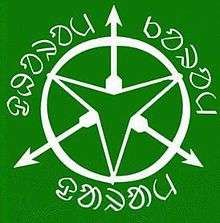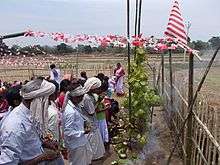Sarnaism


Sarnaism or Sarna[1][2][3] (local languages: Sarna Dhorom or Sarna Dharam, meaning "religion of the woods"), also known as Sariism (Sari Dharam, literally "sal tree religion") or Adiism (Adi Dharam, literally "original religion"), is the collective designation of the indigenous religions of the Adivasi populations of the states of Jharkhand, Odisha, West Bengal, Bihar, and Chhattisgarh, centred around the worship of nature represented by trees. Followers of these religions primarily belong to the Munda, Ho, Bhumij, Santal and Khuruk ethnic groups.
Etymology
Sarna means "grove" and it is etymologically related to the name of the sal tree, sacred to the religion, from which also derives Sari Dhorom ("religion of the sal tree"). A large population of Munda, Ho, Santal, Bhumij and Kurukh continue to practice Sarnaism.
History
Sarna followers have been organising protests and petitions to have their religion recognised by the government of India in census forms.[4][5]
Theology
Adherents of Sarnaism believe in, worship and revere Dharmesh,[6] or God as the creator of the universe, who is also called Marang Buru, Singbonga or by other names by different tribes. Adherents also believe in, worship and revere Chalapachho Devi, the mother goddess, identified as the earth, nature, and the world tree, symbolised by the sal tree. Dharmesh is believed to manifest himself in sal trees.
Worship places and rites

Sarna temples are called Jaher than or Jaher gar, and can be found in villages, while worship can be performed also in jaher, or sacred groves. Sal trees are present both in the temples and the sacred grove. The ceremonies are performed by the whole village community at a public gathering with the active participation of village priests, pahan. The chief assistant of village priest is called Naike.
Organisations
- Akhil Bharatiya Sarna Dharam (ABSD)
- All India Sarna Dharam Mandowa (AISDM)
Demographics
- Jharkhand — 4,223,500
- Odisha — 500,000 to 1,000,000 (estimated)
- Census 2011 of Jharkhand and Odisha: 4,957,000[7]
- Assam — 1,000,000 to 1,500,000 (estimated)
- Bihar — 1,349,460 (estimated)
- West Bengal — 1,237,121 (estimated)
- Chhattisgarh - 768,910 (estimated)
Bibliography
- A. K. Sachchidananda. Elite and Development. Concept Publishing Co., New Delhi, 1980. ASIN B000MBN8J2
- James Minahan. Ethnic Groups of South Asia and the Pacific: An Encyclopedia. Series: Ethnic Groups of the World. ABC-CLIO, 2012. ISBN 1598846590
- Kishor Vidya Niketan. The Spectrum of Tribal Religion in Bihar: A Study of Continuity & Change Among the Oraon of Chotanagpur. 1988.
- Malini Srivastava. The Sacred Complex of Munda Tribe. Department of Anthropology, University of Allahabad, Allahabad 211 002, Uttar Pradesh, India. Anthropologist, 9(4): 327-330 (2007)
- Phatik Chandra Hembram. Sari-Sarna (Santhal Religion). Mittal Publications, 1988. ISBN 8170990440
Documents
- Oraons & Sarna Religion. Articles On Jharkhand, Its Tribal People & Tribal Society.
- Koenraad Elst. The Sarna: a case study in natural religion.
References
- ↑ Minahan, 2012. p. 236
- ↑ Sachchidananda, 1980. p. 235
- ↑ Srivastava, 2007.
- ↑ Santosh K. Kiro. Delhi demo for Sarna identity. The Telegraph, 2013.
- ↑ Pranab Mukherjee. Tribals to rally for inclusion of Sarna religion in census. Times of India, 2013.
- ↑ Minahan, 2012. p. 236
- ↑ Zeeshan Shaikh for The Indian Express: "Fewer minor faiths in India now, finds Census; number of their adherents up".